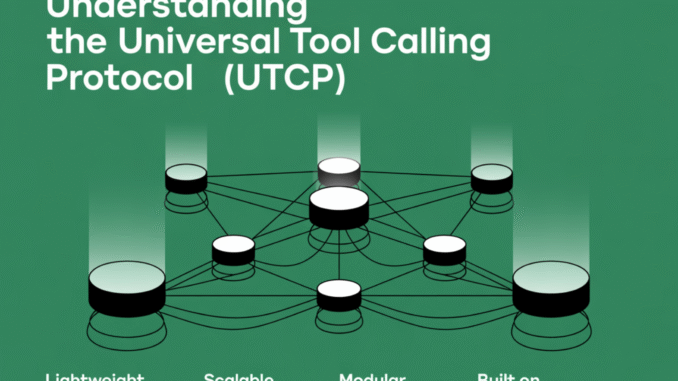
The Universal Tool Calling Protocol (UTCP) is a lightweight, secure, and scalable way for AI agents and applications to find and call tools directly, without the need for additional wrapper servers.
Key Features
Lightweight and secure – Allows tools to be accessed directly, avoiding unnecessary middle layers.
Scalable – Can support a large number of tools and providers without losing performance.
Modular design – Version 1.0.0 introduces a plugin-based core, making the protocol easier to extend, test, and package.
Built on Pydantic models – Provides simple, well-defined data structures that make implementation straightforward.
The Problem with Current Approaches
Traditional solutions for integrating tools often require:
Building and maintaining wrapper servers for every tool
Routing all traffic through a central protocol or service
Reimplementing authentication and security for each tool
Accepting additional latency and complexity
These steps add friction for developers and slow down execution.
The UTCP Solution
UTCP offers a better alternative by:
Defining a clear, language-agnostic standard for describing tools and their interfaces
Allowing agents to connect directly to tools using their native communication protocols
Providing an architecture that lets developers add:
New communication protocols (HTTP, SSE, CLI, etc.)
Alternative storage systems
Custom search strategies
All of this can be done without modifying the core library.
By eliminating the need for wrapper servers or other heavy middle layers, UTCP streamlines the way AI agents and applications connect with tools. It reduces latency and overall complexity, since requests no longer have to pass through extra infrastructure. Authentication and security become simpler as well, because UTCP allows agents to use the tool’s existing mechanisms rather than duplicating them in an intermediary service. This leaner approach also makes it easier to build, test, and maintain integrations, while naturally supporting growth as the number of tools and providers increases.
How It Works
UTCP makes tool integration simple and predictable. First, an AI agent discovers your tools by fetching a UTCP manual, which contains definitions and metadata for every capability you expose. Next, the agent learns how to call these tools by reading the manual and understanding the associated call templates. Once the definitions are clear, the agent can invoke your APIs directly using their native communication protocols. Finally, your API processes the request and returns a normal response. This process ensures seamless interoperability without extra middleware or custom translation layers.
Architecture Overview
Version 1.0 of UTCP introduces a modular, plugin-based architecture designed for scalability and flexibility. At its core are manuals, which define tools and their metadata, as well as call templates that specify how to interact with each tool over different protocols.
The UTCP Client acts as the engine for discovering tools and executing calls. Around this core is a plugin system that supports protocol adapters, custom communication methods, tool repositories, and search strategies. This separation of concerns makes it easy to extend the system or customize it for a particular environment without altering its foundation.
How is UTCP different from MCP?
UTCP and MCP both help AI agents connect with external tools, but they focus on different needs. UTCP enables direct calls to APIs, CLIs, WebSockets, and other interfaces through simple JSON manuals, keeping infrastructure light and latency low. MCP provides a more structured layer, wrapping tools behind dedicated servers and standardizing communication with JSON-RPC.
Key points:
Architecture: UTCP connects agents straight to tools; MCP uses a server layer for routing.
Performance & Overhead: UTCP minimizes hops; MCP centralizes calls but adds a layer of processing.
Infrastructure: UTCP requires only manuals and a discovery endpoint, while MCP relies on servers for wrapping and routing.
Protocol Support: UTCP works across HTTP, WebSocket, CLI, SSE, and more; MCP focuses on JSON-RPC transport.
Security & Auth: UTCP uses the tool’s existing mechanisms, while MCP manages access inside its servers.
Flexibility: UTCP supports hybrid deployments through its MCP plugin, while MCP offers centralized management and monitoring.
Both approaches are useful: UTCP is ideal for lightweight, flexible integrations, while MCP suits teams wanting a standardized gateway with built-in control.

Conclusion
UTCP is a versatile solution for both tool providers and AI developers. It lets API owners, SaaS providers, and enterprise teams expose services like REST or GraphQL endpoints to AI agents in a simple, secure way. At the same time, developers building agents or applications can use UTCP to connect effortlessly with internal or external tools. By removing complexity and overhead, it streamlines integration and makes it easier for software to access powerful capabilities.

I am a Civil Engineering Graduate (2022) from Jamia Millia Islamia, New Delhi, and I have a keen interest in Data Science, especially Neural Networks and their application in various areas.





Be the first to comment